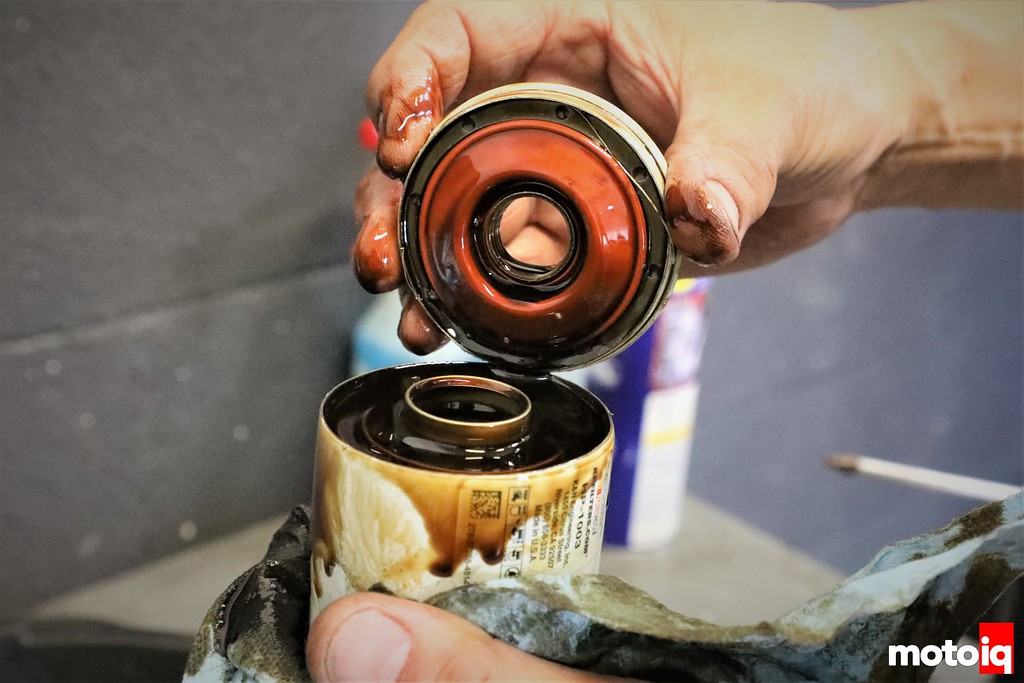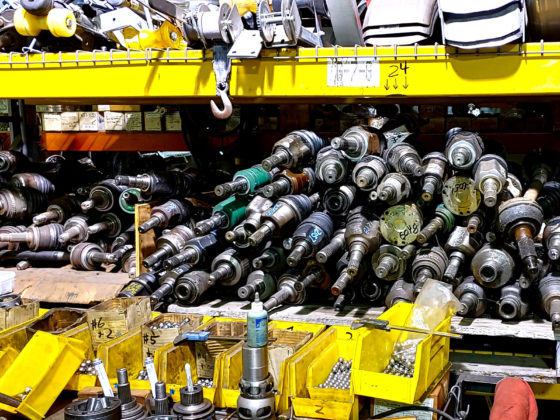
Here is a close up of the oil filter element. Inspect the pleats of the element carefully. What you are looking for are shavings which are very bad, these using come from dying thrust bearings or if you spun a bearing and its pieces of bearing material, the steel bearing backing and your block or rods. Usually, this is accompanied by a big drop in oil pressure and loud knocking noises coming from your engine’s bottom end. Usually, most of the shavings are magnetic. Sometimes shavings also come from the valvetrain and are from the cam and cam followers. This is usually accompanied by ticking or knocking noises coming from the top of the engine.
The other thing you are looking for is flat flakes shaped metallic particles. These are usually not magnetic. These are coming from the engines bearings and are not a good sign either.

The end of the oil filter case is where a lot of metal debris accumulate. The oil flow stagnates in this area and a lot of the metal in the oil ends up deposited here, usually, most of the metal debris are found here, often more than what ends up on the filter element. I usually pour this small amount of oil onto a clean paper towel and inspect it for metallic debris then inspect and wipe out the case with a clean towel looking for any metal or other material on the towel. I also usually look at the anti-drain back valve spring that sits in the bottom of the case to see if there is any material on it as well.
If you see these sorts of particles in the filter, it is probably a good idea to tear down your motor and find their source as there presence means that something bad has happened or is in the process of happening and if the motor is torn down and repaired now, a catastrophic and much more expensive failure can be avoided.




7 comments
You can also remove the filter element from the stamped steel end pieces and lay it out on a clean piece of paper or a drain pan. You can use a box-cutter to remove the paper element.
That is a good idea as well.
This is a great idea. I like that newer German vehicles make this easier with a replaceable filter, instead of a canister (saves on waste, too.)
I also do a couple things that I learned from watching Best Motoring, on all my filters:
One is to put neodymium magnets on various locations of the filter, although I should probably cut one apart to see if I am collecting bits of iron.
Second, is to use two hose clamps (especially on big filters), around the filter (not too tight), as the thin steel walls of the canister will actually flex under high oil pressure, and the volume change can actually effect your oil pressure. This would be more important with Honda VTEC motors, as VTEC engagement depends on oil pressure being high enough to actuate the VTEC solenoid.
The hose clamp is actually to prevent blowing off the filter case if you have disabled the bypass which some racers do. The magnets will collect ferrous debris but not non-ferrous like aluminum and bearing material.
Hi Mike,
Yeah, the magnets and hose clamps are cheap, easy mods, so I do them on my cars (my current vehicle has a huge oil filter, so the walls might actually flex a little bit.) Also, I know that not all oil filters have bypass valves, too. (Although, I always buy them with a bypass.)
I got the ‘hose clamp tip’ from an episode of Best Motoring VTEC Club with Spoon’s Ichishima-san. The hose clamps also help when it comes to removal if you have a stubborn filter.
Interestingly, they also sell a ‘ASM Oil Filter Stopper’, that utilizes a hose clamp wired to a small bracket. I am pretty sure that just about anybody could fabricate an oil filter stopper for themselves. (I had no idea that a filter could spin off on an S2000. Wow! That’s gotta suck.)
http://www.gotuning.com/product_info.php?fPath=S2000_2_42&products_id=923
Actually, I didn’t know much about how/when the Bypass Valve operates, so this forced me to do some schooling:
The Bypass Valve
Under ideal conditions, the bypass valve will never open. When it opens, the oil by passes the filter and goes on through to the motor, obviously unfiltered. It is a safety valve. However, in real operation, it opens often.
One example is when you start the motor when cold. The oil is thick and does not pass easily through the filtration medium, thus building up to a high pressure drop. So, the bypass valve opens to prevent oil-starvation of the motor. How long it stays open is dependent on how cold the oil is and how long it takes to get near operating temperature. When the pressure drop across the filtration medium drops below the bypass valve setting.
Another example can occur when the motor is fully warmed. At idle, the oil pressure is about 15 to 20 psi, and the pressure drop across the filter is about 1 or 2 psi. You take off towards the redline, and quickly build oil pressure. During that full-throttle acceleration the pressure drop across the filter will exceed the bypass setting, and send unfiltered oil to the motor, until the pressure across the filter has time to equalize. During a drag race, shifting through the gears, the bypass will open several times.
A third example, which you should never experience with frequent oil and filter changes, is when a filter becomes clogged. A spin-on filter can commonly hold 10 to 20 grams of trash before it becomes fully clogged. The bypass valve opening is the only way to keep the motor from becoming oil-starved if the filter becomes clogged.
According to Purolator, the Honda OEM filter bypass setting is 12 to 14 psi. WIX (NAPA Gold) builds their oil filters with a bypass setting of 8 to 11 psi, while AC Delco builds theirs to a setting of 11 to 17 psi. How much do these differences matter? I don’t think anyone knows, even the engineers, and each has its own set of advantages and disadvantages.
If you do lots of racing, you’re probably better off with a higher bypass setting.
If you do lots of *cold* starting, especially in the winter, or seldom change your filter, I think you’re better off with a lower bypass setting. However, with few exceptions, bypass pressures for spin-on filters run in the 8 to 17 psi range, and any of them should work acceptably.
As you can see, some bypass valves are built directly in the middle of the filter while a few do not have one.
https://www.bobistheoilguy.com/forums/ubbthreads.php?ubb=showflat&Number=309756
Thank you for this useful information. Keep it up
In case of new bearings or other components break-in period should we expect more debris to accumulate there? And if so, by how much more?
Thanks